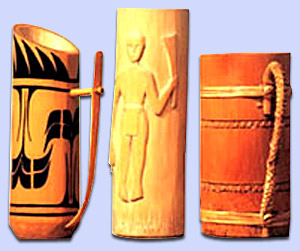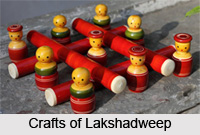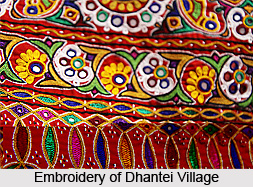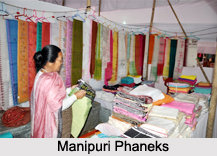 Textiles of Manipur encompass those of the valley where the bulk of population are the Meitheis, who believe that the art of weaving was taught to them by their deity Panthoibi during mythological era, when the goddess learnt the art from the spiders who were weaving their cobwebs. Given a female deity introduced weaving, all the weavers in Manipur are women. Other speculations include the story of the princess Thoibi of Moirang principality, who after being deported to Kabow valley learnt the science of sericulture and silk weaving which she introduced in Manipur upon return. Perhaps this is why bulk of silk weavers is still referred to as Kabo weavers.
Textiles of Manipur encompass those of the valley where the bulk of population are the Meitheis, who believe that the art of weaving was taught to them by their deity Panthoibi during mythological era, when the goddess learnt the art from the spiders who were weaving their cobwebs. Given a female deity introduced weaving, all the weavers in Manipur are women. Other speculations include the story of the princess Thoibi of Moirang principality, who after being deported to Kabow valley learnt the science of sericulture and silk weaving which she introduced in Manipur upon return. Perhaps this is why bulk of silk weavers is still referred to as Kabo weavers.
Weaving in Manipur has evolved from the traditional simple back strap type loom otherwise known as Loins loom or Indonesian Tension loom, to throw shuttle looms and subsequently to fly shuttle looms, with simultaneous introduction of various design gadgets like draw boy or dobby, and even Jacquard along with original design concepts. However, discontinuation of spinning, ginning etc. to large extent became a reality in the state just like the rest of India, due to gradual development of mill made yarns. Of course, there are exceptions.
Meitheis, the largest community in Manipur, have hand spun and hand woven cotton fabric as a facet of their traditional ritual, say their principal festival Lai Haraoba, when the traditional priests and priestesses (the Meibas and Meibis) not only use hand spun and hand woven fabrics but also those who participate in the procession. Spinning of cotton thus continues even today and the spinning wheel or "Tareng" is still the household implement. There are few places like Khonjam and Kakching, known for high quality hand spun yarn. Perhaps, Manipur is the only state where Tareng or Charkha is today being sold as an essential implement.
Silk and Sericulture have their own stories for their origin in Manipur. As per Major W. McCulloch, the art of silk and sericulture originated in the land and later went to China where it started spreading elsewhere. Another story says silk was introduced in Manipur about 600 years back during the rule of King Khangemba, who is said to have had defeated the Chinese army and took few Chinese soldiers as war prisoners, allowing them to settle in Kamen, a Loi hamlet. Many of them were believed to know the art of sericulture and technology of silk textile that they introduced in their settlement. Since they married various Loi girls, the technology percolated to the Lois. This is perhaps why sericulture is still practiced in Loi villages such as Laimram, Sekmai, Khur Khul and Kakching. Another legend is the story of Princess Thoibi. Traditionally, the Lois and the Meitheis used to rear Mulberry and Eri worms reel and spin yarn from cocoons, producing various fabrics as per the demand. When the Meitheis were Hindunised, they considered reeling of worms as low caste job, thus discontinued leaving Lois to continue with it. Rearing of Tassar worm however was introduced in the hills as part of Government programmes, as subsidiary occupation of various tribes, using Oak as feed plant. It is yet to be established as a successful economic occupation.
Be it the hills or the valley, the indispensable facet of weaving in Manipur are women. Textile operation from beginning to end is basically the affairs of women and men have no entry. It is said, a girl who does not know weaving cannot get her match for conjugal life. A loom is certainly a proud possession of a woman of Manipur, irrespective of the community she belongs.
Textiles of Meitheis of Manipur
Meitheis are the largest group of people in Manipur. Major W. McCulloch reported on their attire that the men dressed in the same way as those in the rest of the country; but the Manipuris far surpassed the others in the cleanliness of their garments. Various articles of dress and ornaments could not be worn unless it was permitted by the Raja, which was much coveted. Persons of high rank were permitted to have carried before them a red woollen cloth and a cloth of cotton manufacture. These they used as rugs to sit on which are prized; as dresses they could be used by any who could afford them. The women attire was quite different from that worn by the rest in the country, consisting of a stripped cotton or silk cloth passed round the body under the armpits and over the breasts, a jacket and a sheet.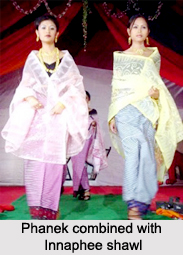
Another scholar Dr. R. Brown reported in more detail on the attire, stating the men"s dress did not differ materially from that of the Bengalis, consisting of a dhoti, kurta or occasionally shirt, and a "chudder" or sheet. In winter, those who could afford wore a quilted and padded coat generally having long uncomfortable sleeves and enormously high colours. Shoes were seldom worn. Their "pugree" was shorter than that worn by Hindustanis, but put on in same manner. Women"s dress, when of good quality, was picturesque and pleasing. During the hot weather, it consisted of a piece of cloth open except at the bottom, where it is stitched together by the edges for a few inches; it was folded round the body, under the armpits and over the breasts, and tucked in by the hand at the arm. In length it reached the ground, but hitched up half way to the knee for walking, and tucked in again at the waist. This piece of cloth is called "Phanek", wide enough to go one and a half times round the body, giving enough room for the legs to walk. It is made in cotton and silk and only patterns and stripes of various colours and widths run across the material, the ground work being of different colours. The commoner patterns are red with green stripes, green and black, blue with black and white stripes, yellow and brown, dark blue with green and white stripes etc. At the top and bottom of the garment is a broad margin where geometrical figures are sewn by hand with multicoloured floss silk. Over the Phanek was worn a white sheet, folded in usual native manner, the face being left uncovered. In the cold season, a short jacket with long sleeves was worn, reaching below the bust over the Phanek, fitting tight, the material being usually velvet or satin, black, blue or green the favourite colours. Girls until puberty or near wore the Phanek round the waist, the upper part of the body being bare. The white sheet worn over the Phanek, called In-na-phee, is beautiful white muslin either plain or embroidered with white thread.
The style of wearing Phanek by many modern Meithei women has undergone change in past few decades, with the adoption of Assamese Mekhala style by using a 2.5 metre long half saree over a modern blouse. The older style continues amongst rural women in villages and the Lois. The style of Panggens (Muslim Meitheis) is slightly different both in respect of combinations and wearing style. Phaneks are woven out of hand spun yarn, dyed in various colours and then woven in either throw shuttle or fly shuttle looms. The embroidered designs are brought out with dobby. However, nowadays coloured mill yarns are used. In-na-phee was woven out of hand spun yarn mostly around the great Loktak Lake, spinning and weaving of finer cotton requiring humid climate. Coarse sheets made out of hand spun yarn with the help of Tareng are popular bed spreads and body covers in winter as well as shawls. They are made from short staple cotton grown by the Meitheis, the Lois or the tribes. The tradition still continues along Imphal-Morey-Tamu highway. Often yarns are dyed in various colours to produce shawls of different designs.
Related Articles:
Manipur
Crafts of Manipur
Tribes of Manipur
Meithei Language
Indian Costumes
Weaving and Dyeing Craft
Silk Weaving in South India
Cotton Fabrics
Silk
Ornaments of Manipur



